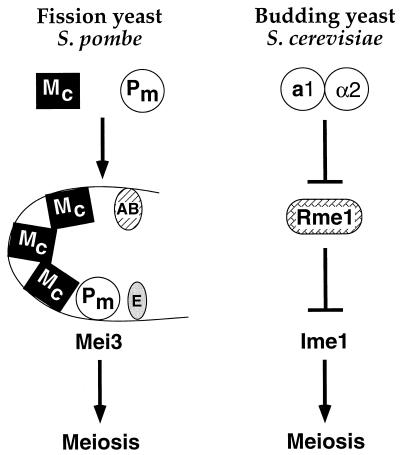FIG. 6.
Different regulatory logic for cell type control of the key meiosis-inducing genes in fission and budding yeasts. In S. pombe, diploids express two distinct DNA-binding proteins, Mc, which contains an HMG domain, and Pm, which contains a homeodomain homologous to α2. Pm binds to element D of the mei3 promoter, and Mc is likely (but not directly shown) to bind multiple sites within element C. These proteins, together with putative proteins interacting with elements E and A or B, stimulate transcription of mei3, the trigger for meiosis. Haploids do not undergo meiosis because Pm and perhaps these other proteins are not present or active. Given the unusual properties of element C, we speculate that mei3 transcription requires the formation of an enhancesome that depends on DNA-binding and bending properties of the HMG protein Mc (see text). In S. cerevisiae, haploids do not undergo meiosis because they express Rme1, a repressor that binds the promoter of IME1, the key meiosis-inducing gene. Diploids can undergo meiosis because they specifically express the a1 and α2 homeodomain proteins, which form a heterodimeric repressor that directly binds the RME1 promoter and blocks production of Rme1. Hence, a1-α2 indirectly cause the expression of Ime1 by repressing a repressor, whereas Pm and presumably Mc directly bind the mei3 promoter and activate transcription. Furthermore, α2 functions as a repressor whereas the homologous Pm functions as an activator. The key meiosis-inducing proteins, Mei3 and Ime1, have unrelated molecular functions, and the pathways downstream of these proteins are completely different.

